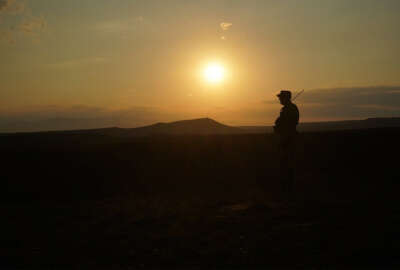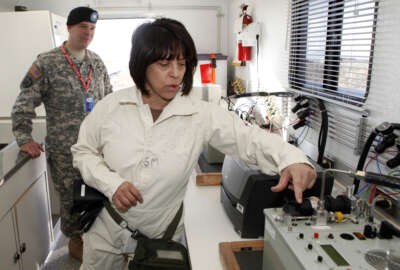
Army wants to lock soldiers’ biometrics in with machines to create sci-fi-like effects
The new suite of tools tracks soldiers' movements and distills it into data.
Have you ever been watching a sci-fi movie and a drone comes to the rescue just in the nick of time, or a technology deploys right when a character needs it most?
The Army wants that, too — and it’s working with the nascent technology now to improve situational awareness to better team with robots, drones, other humans and anything else that may come along the way.
The Army Research Lab, along with the Navy, is using a new suite of software tools to track the biometrics of soldiers and sailors — everything from pupil size to eye movement to heart rate and breathing patterns.
“The future squad is not just going to be humans,” Russell Cohen Hoffing, a scientist at the Army Research Lab told Federal News Network. “There’s going to be agents involved — robots, some intelligent adaptive systems, drones, software. Our systems will passively look at physiology of soldiers and use that to create a map to paint a picture of situational awareness. You could have a drone immediately infer where a soldier is interested and go and explore that area, and this is again having all passively without a soldiers input at all.”
The software would read a service member’s pupil size, for example, and infer that there is an area that needs to be checked out and then go check out the area. The software could sense an extreme increase in heart rate, assume a service member is in danger, and come to the rescue. There are numerous possibilities, some of which haven’t even been imagined yet.
“We are looking at ways to leverage opportunistically sensed data to maximize soldier and team performance in complex environments,” Bill Evans, chief of the integrated capabilities branch at ARL, said.
Before ARL can get there though, it needs to find the best ways to track biometrics and then synthesize that data into something artificial intelligence and software can use to recognize what soldiers need.
Cohen Hoffing said a lot of the work being done right now is in virtual reality where soldiers will wear goggles that present certain scenarios, and then scientists can collect biometric data.
Those goggles, called the Integrated Visual Augmentation System (IVAS), are being used by the Army as a whole to improve what a soldier sees in the field.
“The IVAS prototype heads up display packs a variety of impressive capabilities into one package. Night vision and thermal scope settings are both available at the press of a button,” an Army release states. “Soldiers can share topographical imagery or 3D maps of an objective at any time, whether rehearsing or in the field. A soldier can pair the IVAS to a weapon, enabling the weapon to be aimed using a reticle projected into their field of vision rather than holding it at the shoulder and peering through the scope. All members of a platoon can know where all of their teammates are at a given time, no matter how dark or dense the surrounding terrain.”
The Army’s work now is to continue to develop ways to sense biometric data that are easy for soldiers and sailors to wear and to find ways to make the data understandable and translatable to other systems.
“Without meaningful analysis of pupil size, for example, it is just a number of millimeters at any given time point,” Cohen Hoffing said.
Copyright © 2025 Federal News Network. All rights reserved. This website is not intended for users located within the European Economic Area.
Scott Maucione is a defense reporter for Federal News Network and reports on human capital, workforce and the Defense Department at-large.
Follow @smaucioneWFED






